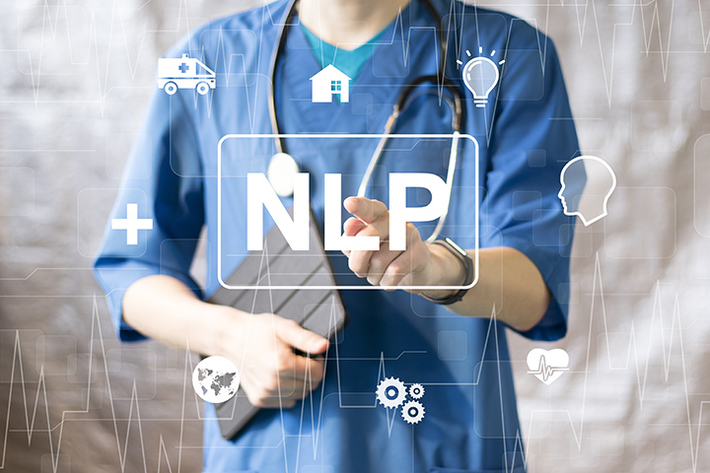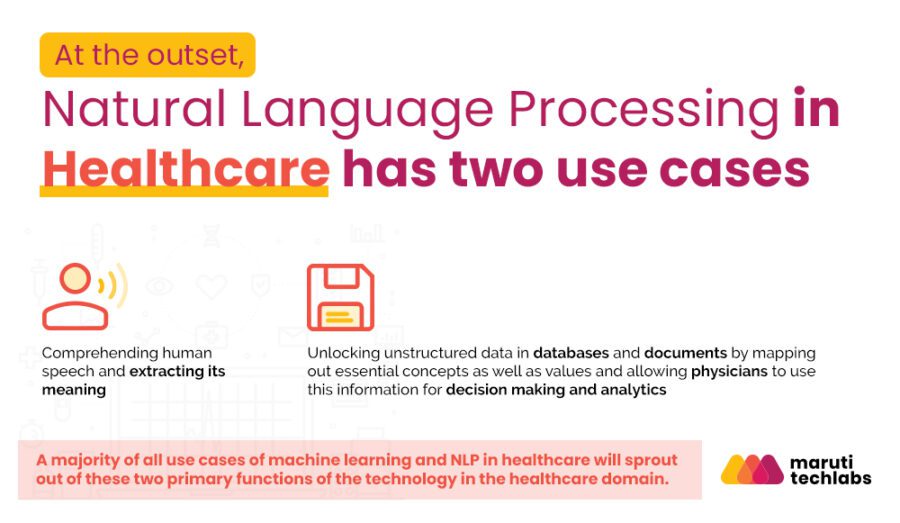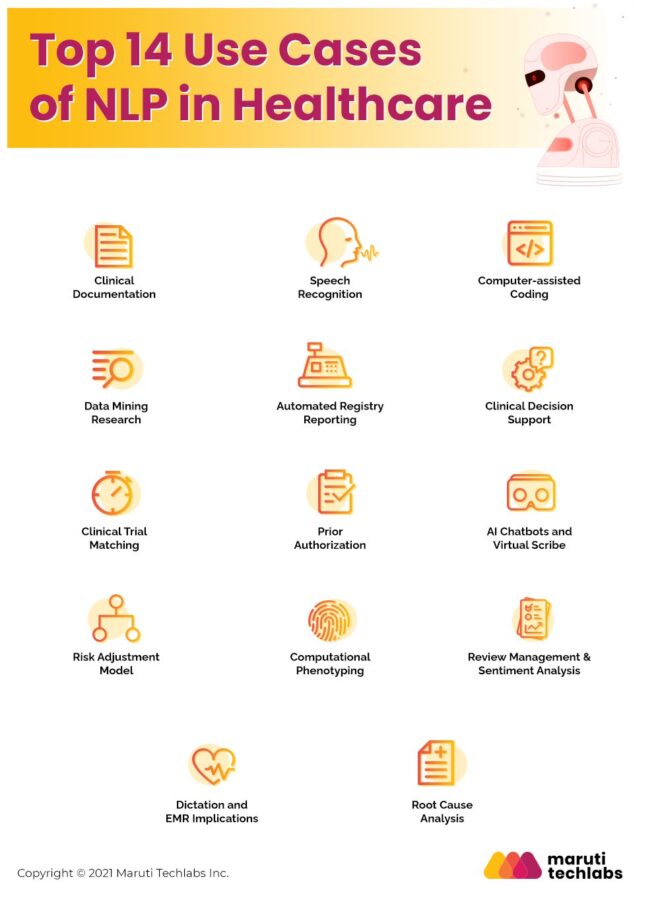
NLP or Natural Language Processing in healthcare presents some unique and stimulating opportunities. It provides a glide through the vast proportion of new data and leverages it for boosting outcomes, optimising costs, and providing optimal quality of care.
Better access to data-driven technology as procured by healthcare organisations can enhance healthcare and expand business endorsements. But, it is not simple for the company enterprise systems to utilise the many gigabytes of health and web data. But, not to worry, the drivers of NLP in healthcare are a feasible part of the remedy.
What is NLP in Healthcare?
The NLP illustrates the manners in which artificial intelligence policies gather and assess unstructured data from the language of humans to extract patterns, get the meaning and thus compose feedback. This is helping the healthcare industry to make the best use of unstructured data. This technology facilitates providers to automate the managerial job, invest more time in taking care of the patients, and enrich the patients experience using real-time data.
 https://cdn-gcp.marutitech.com/wp-media/2019/06/e089d3e2-nlp1-768×4… 768w, https://cdn-gcp.marutitech.com/wp-media/2019/06/e089d3e2-nlp1-705×4… 705w, https://cdn-gcp.marutitech.com/wp-media/2019/06/e089d3e2-nlp1-450×2… 450w” sizes=”(max-width: 1000px) 100vw, 1000px” />
https://cdn-gcp.marutitech.com/wp-media/2019/06/e089d3e2-nlp1-768×4… 768w, https://cdn-gcp.marutitech.com/wp-media/2019/06/e089d3e2-nlp1-705×4… 705w, https://cdn-gcp.marutitech.com/wp-media/2019/06/e089d3e2-nlp1-450×2… 450w” sizes=”(max-width: 1000px) 100vw, 1000px” />
You will be reading more in this article about the most effective uses and role of NLP in healthcare corporations, including benchmarking patient experience, review administration and sentiment analysis, dictation and the implications of EMR, and lastly the predictive analytics.
14 Best Use Cases of NLP in Healthcare
Let us have a look at the 14 use cases associated with Natural Language Processing in Healthcare:
1. Clinical Documentation
The NLPs clinical documentation helps free clinicians from the laborious physical systems of EHRs and permits them to invest more time in the patient; this is how NLP can help doctors. Both speech-to-text dictation and formulated data entry have been a blessing. The Nuance and M*Modal consists of technology that functions in team and speech recognition technologies for getting structured data at the point of care and formalised vocabularies for future use
The NLP technologies bring out relevant data from speech recognition equipment which will considerably modify analytical data used to run VBC and PHM efforts. This has better outcomes for the clinicians. In upcoming times, it will apply NLP tools to various public data sets and social media to determine Social Determinants of Health (SDOH) and the usefulness of wellness-based policies.
2. Speech Recognition
NLP has matured its use case in speech recognition over the years by allowing clinicians to transcribe notes for useful EHR data entry. Front-end speech recognition eliminates the task of physicians to dictate notes instead of having to sit at a point of care, while back-end technology works to detect and correct any errors in the transcription before passing it on for human proofing.
The market is almost saturated with speech recognition technologies, but a few startups are disrupting the space with deep learning algorithms in mining applications, uncovering more extensive possibilities.
3. Computer-Assisted Coding (CAC)
CAC captures data of procedures and treatments to grasp each possible code to maximise claims. It is one of the most popular uses of NLP, but unfortunately, its adoption rate is just 30%. It has enriched the speed of coding but fell short at accuracy.
4. Data Mining Research
The integration of data mining in healthcare systems allows organizations to reduce the levels of subjectivity in decision-making and provide useful medical know-how. Once started, data mining can become a cyclic technology for knowledge discovery, which can help any HCO create a good business strategy to deliver better care to patients.
5. Automated Registry Reporting
An NLP use case is to extract values as needed by each use case. Many health IT systems are burdened by regulatory reporting when measures such as ejection fraction are not stored as discrete values. For automated reporting, health systems will have to identify when an ejection fraction is documented as part of a note, and also save each value in a form that can be utilized by the organizations analytics platform for automated registry reporting.
6. Clinical Decision Support
The presence of NLP in Healthcare will strengthen clinical decision support. Nonetheless, solutions are formulated to bolster clinical decisions more acutely. There are some areas of processes, which require better strategies of supervision, e.g., medical errors.
According to a report, recent research has indicated the beneficial use of NLP for computerised infection detection. Some leading vendors are M*Modal and IBM Watson Health for NLP-powered CDS. In addition, with the help of Isabel Healthcare, NLP is aiding clinicians in diagnosis and symptom checking.
7. Clinical Trial Matching
Using NLP and machines in healthcare for recognising patients for a clinical trial is a significant use case. Some companies are striving to answer the challenges in this area using Natural Language Processing in Healthcare engines for trial matching. With the latest growth, NLP can automate trial matching and make it a seamless procedure.
One of the use cases of clinical trial matching is IBM Watson Health and Inspirata, which have devoted enormous resources to utilise NLP while supporting oncology trials.
 https://cdn-gcp.marutitech.com/wp-media/2019/06/69e697fc-nlp_in_hea… 768w, https://cdn-gcp.marutitech.com/wp-media/2019/06/69e697fc-nlp_in_hea… 517w, https://cdn-gcp.marutitech.com/wp-media/2019/06/69e697fc-nlp_in_hea… 450w” sizes=”(max-width: 1000px) 100vw, 1000px” />
https://cdn-gcp.marutitech.com/wp-media/2019/06/69e697fc-nlp_in_hea… 768w, https://cdn-gcp.marutitech.com/wp-media/2019/06/69e697fc-nlp_in_hea… 517w, https://cdn-gcp.marutitech.com/wp-media/2019/06/69e697fc-nlp_in_hea… 450w” sizes=”(max-width: 1000px) 100vw, 1000px” />
8. Prior Authorization
Analysis has demonstrated that payer prior authorisation requirements on medical personnel are just increasing. These demands increase practice overhead and holdup care delivery. The problem of whether payers will approve and enact compensation might not be around after a while, thanks to NLP. IBM Watson and Anthem are already up with an NLP module used by the payers network for deducing prior authorisation promptly.
9. AI Chatbots and Virtual Scribe
Although no such solution exists presently, the chances are high that speech recognition apps would help humans modify clinical documentation. The perfect device for this will be something like Amazons Alexa or Googles Assistant. Microsoft and Google have tied up for the pursuit of this particular objective. Well, thus, it is safe to determine that Amazon and IBM will follow suit.
Chatbots or Virtual Private assistants exist in a wide range in the current digital world, and the healthcare industry is not out of this. Presently, these assistants can capture symptoms and triage patients to the most suitable provider. New startups formulating chatbots comprise BRIGHT.MD, which has generated Smart Exam, a virtual physician assistant that utilises conversational NLP to gather personal health data and compare the information to evidence-based guidelines along with diagnostic suggestions for the provider.
Another virtual therapist started by Woebot connects patients through Facebook messenger. According to a trial, it has gained success in lowering anxiety and depression in 82% of the college students who joined in.
10. Risk Adjustment and Hierarchical Condition Categories
Hierarchical Condition Category coding, a risk adjustment model, was initially designed to predict the future care costs for patients. In value-based payment models, HCC coding will become increasingly prevalent. HCC relies on ICD-10 coding to assign risk scores to each patient. Natural language processing can help assign patients a risk factor and use their score to predict the costs of healthcare.
11. Computational Phenotyping
In many ways, the NLP is altering clinical trial matching; it even had the possible chances to help clinicians with the complicatedness of phenotyping patients for examination. For example, NLP will permit phenotypes to be defined by the patients current conditions instead of the knowledge of professionals.
To assess speech patterns, it may use NLP that could validate to have diagnostic potential when it comes to neurocognitive damages, for example, Alzheimers, dementia, or other cardiovascular or psychological disorders. Many new companies are ensuing around this case, including BeyondVerbal, which united with Mayo Clinic for recognising vocal biomarkers for coronary artery disorders. In addition, Winterlight Labs is discovering unique linguistic patterns in the language of Alzheimers patients.
12. Review Management & Sentiment Analysis
NLP can also help healthcare organisations manage online reviews. It can gather and evaluate thousands of reviews on healthcare each day on 3rd party listings. In addition, NLP finds out PHI or Protected Health Information, profanity or further data related to HIPPA compliance. It can even rapidly examine human sentiments along with the context of their usage.
Some systems can even monitor the voice of the customer in reviews; this helps the physician get a knowledge of how patients speak about their care and can better articulate with the use of shared vocabulary. Similarly, NLP can track customers attitudes by understanding positive and negative terms within the review.
13. Dictation and EMR Implications
On average, EMR lists between 50 and 150 MB per million records, whereas the average clinical note record is almost 150 times extensive. For this, many physicians are shifting from handwritten notes to voice notes that NLP systems can quickly analyse and add to EMR systems. By doing this, the physicians can commit more time to the quality of care.
Much of the clinical notes are in amorphous form, but NLP can automatically examine those. In addition, it can extract details from diagnostic reports and physicians letters, ensuring that each critical information has been uploaded to the patients health profile.
14. Root Cause Analysis
Another exciting benefit of NLP is how predictive analysis can give the solution to prevalent health problems. Applied to NLP, vast caches of digital medical records can assist in recognising subsets of geographic regions, racial groups, or other various population sectors which confront different types of health discrepancies. The current administrative database cannot analyse socio-cultural impacts on health at such a large scale, but NLP has given way to additional exploration.
In the same way, NLP systems are used to assess unstructured response and know the root cause of patients difficulties or poor outcomes.
This article was originally published here
